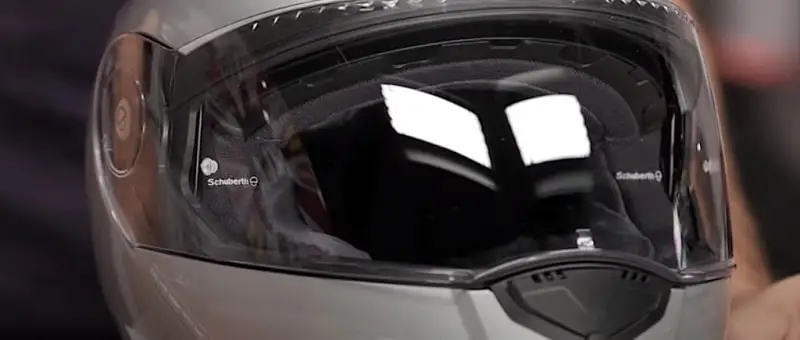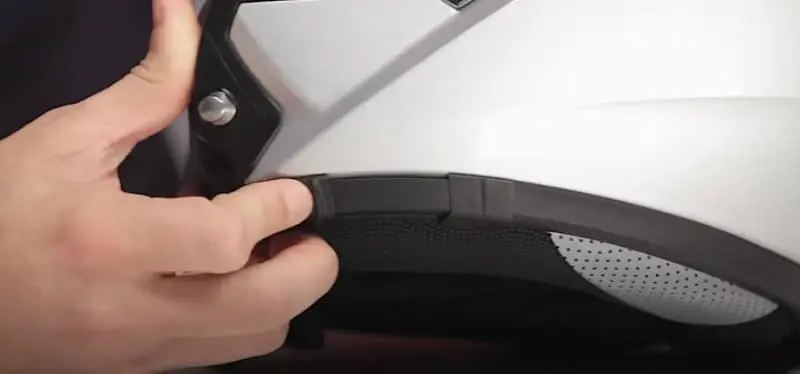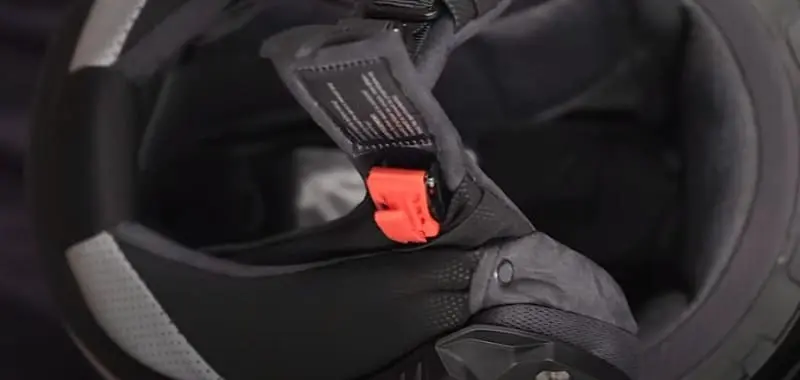The Schuberth’s C3 Pro must be one of the longest-running helmets on the market now, and it’s been so popular for so long that any other flip front that Schuberth ever comes up with will have a lot to live up to.
The original C3 came out way back in 2008, and this upgraded Pro version came in 2014. ever since that original C3 came out back in 2008, Schuberth has set their stall out that this is their quietest helmet.
You look over it, you look in it, and you ride in one for a little bit, and there are little signs everywhere that this helmet was clearly designed to be quiet.
Loads of those ideas have also inspired other manufacturers over the years, and I’ll point out some of those as I run through what you need to know about the C3 Pro helmet.

Schuberth’s C3 Pro Review
Table of Contents
Shell Construction
Schuberth has a fancy acronym for their shell, STRONG, but it’s mostly fiberglass with some other fibers to make it slightly lighter.
Weight
Sometimes helmets made mostly from fiberglass for the shell end up a bit weighty, but it’s not the case with this one.
This helmet weighed in on our scales at 1509 grams/3.3 lbs which makes this the lightest flip-up helmet we’ve weighed since we started writing these reviews.

Chin Bar Release
The chin bar releases on this helmet with the red button located at the front of the helmet. You push it, and it frees the bar to be raised, the chin bar does click slightly when it’s fully raised, but the chin bar isn’t held up particularly firmly.
The C3 Pro isn’t dual homologated, so it can only legally be worn with the chin bar locked down. (Check Local Laws For Clarity)
When the chin bar locks down, one of the owners’ few criticisms is that it’s not particularly easy to tell if it’s firmly shut because there are not the most pronounced clicks.
I didn’t find that a big issue in the time I spent wearing this lid because this one clicks down, but perhaps it isn’t as loud as some other flips when they close.
Ventilation
One thing that is a big deal for this helmet is the ventilation. The chin vent looks as though it only opens slightly, but it’s pretty damned effective, and a small amount of air flows through the vent, even when it is shut.
Schuberth says they needed that because they’ve made the seal around the helmet’s base so effective that there has to be some air coming through to keep people awake.
The top vent sucks air through and comes through two holes to the top of the head. It channels in that eps impact liner inside, meaning air can travel to the back of the lid and out through vent holes at the back.
There aren’t any exhaust vents coming through the shell, instead, air travels between the EPS and the shell, and then it escapes through the mesh material to the back of the neck roll.

Visor
The visor on this helmet is quite important for noise reduction—the kind of raised teeth on the top edge of the visor, or what Schuberth called turbulators.
They are designed to smooth out the wind flow and stop the whistling noise that can develop when people ride with the visor.
It has two operating tabs at the bottom on either side of the chin vent; this must be one of the first helmets to have those dual tabs.
The visor goes from fully up through four intermediate stages before landing in what’s known as the city position, which leaves a small gap at the bottom for airflow when riding at low speed.
To close it fully, give it a firm push to lock the tab against the chin bar.
The visor on this helmet is a breeze. To remove and replace the visor, you push in the two levers just here, one on each side, which handily stays pushed in, and then you rotate the visor past the vertical, and it will come free of its mounting.
To put it back on, you reverse that by putting the tabs in the right place with the visor just past the vertical and then rotating it back down; it’s that simple.
Sun Visor

There’s a sun visor backing up that main visor too. Its switch slides backward and forwards on the lower left side of the lid, and the final step forward adds a bit more resistance to stop that visor from slipping back down into your view of its own accord.
It’s not coated to Protect against misting. Schuberthsay wanted better optical quality than they could achieve when they had a fog-free coating.
The outer visor and the inner visor on this helmet are both what they call optical class one, which they say would have been compromised by having a coating on the sun visor.
Anti Fogging
The visor is Protected against mist by a Pin-lock insert. Strictly speaking, I’d say it’s not a max vision insert, as it doesn’t sit in a recess on the inside of the visor.
But in practice, it doesn’t need to sit in a recess because it stays clear of the helmet seal when you’re lifting and lowering the visor. It does the job of a max vision insert by covering most of the visible area within the eye-port.

Interior
This helmet’s interior has made this model so popular for so long. The lining is cool max coated so that it won’t overheat, nor will you in summer, and has a classy brushed feeling that’s nice against your skin.
It’s fully removable and tuned to keep the noise down while you’re riding.
Schuberth has gone a step further in making this helmet quiet. The fastening strap, a micrometric buckle, passes through the cheek pads and then comes through the cover.
Once you’ve done it up, a curtain covers the fastening strap on both sides. This means there’s a simpler shape for the air to flow over the fastening strap. Again, the idea is to make the helmet as quiet as possible.
Schuberth has also added velcro to the inner cover so that the strap under the fastening buckle sticks together. This also reduces wind noise.

Schuberth has also introduced another neat touch with the liner. Two small ears in the lining can be folded into the line of the vents. They will cover the holes where the vents come through to the inside of the helmet.
The inside of this helmet also shows something that, as far as I’m aware, is also unique to Schuberth, and that’s their anti-roll-off strap system.
The vast majority of helmets rely on just one strap to keep your lid on your head if you fall off your bike, and that’s the one that goes under your jaw.
Schuberth also uses two extra straps that work with the chin strap to help keep that helmet on your head.
The two extra straps are inside the helmet under the lining. The two extra straps come from the back of the shell and loosen through the main chin strap.
They all work together to stop the helmet from being able to roll off your head.
Removing the liner is a bit of a fiddle with this helmet. It’s not something where you can pull out a few snap closures and chuck the lining in the wash. Instead, everything clips together neatly while putting the lining back in place.
I times myself to see how long it would take to remove the lining, which took eight minutes. It took two minutes to take it out and about six minutes to put it back correctly.
Another classy thing about this helmet is the brushed material that goes over the EPS liner around the head.
Normally you only get bare polystyrene, but not with Schuberth, and that’s just another example of this helmet being a level up from the norm.

Bluetooth
The speaker recesses are elongated, which means you can slide the speakers back and forth to get them in a position that best suits you.
You can fit a regular Center intercom, but you must mount the control unit behind the sun visor switch. Many riders have done that and been happy with the fit, but there is a more tailored solution.
Schuberth and Cena have teamed up to make a dedicated intercom that fits into this helmet. It gives you the controls inside the visor aperture and ensures nothing is protruding from the shell.
There have been a couple of options over the years that this helmet’s been around, but the latest is the SC10UA.
Sizing
The C3 Pro comes in sizes from extra small to triple extra large. In addition, there are two shell sizes for this helmet. The smaller of the two covers everything up to and including size large, while XL, double XL, and triple XL share the bigger of the two shells.
Safety Standards
The C3 Pro meets ECE 2205 approval for the road, and it’s three-star rated in the UK government’s sharp impact testing program, which is in the middle of their rankings. It is also DOT-approved for the American market.
As part of Sharp, the testers record how many of the impacts make the chin bar come open. The C3 Pro remained closed in 97% of the impacts, which is the same score as recorded by the original C3 when tested by sharp.
It’s not unusual for chin bars to open up in that test. 80 out of the 111 flip helmets that Sharp has tested as we write this review had the chin bar come open on at least one of those test impacts.

In Conclusion
So that’s the Schuberth C3 Pro helmet. It’s by far the most detailed helmet I’ve ever had to review, and it’s been designed by a team of people who knew exactly what they were setting out to do.
This helmet was way ahead of its time when the overall design was created back in 2008, and it’s still a great product today and shows no sign of stopping.
There are also loads of customer reviews telling an interesting story. Most customers are blown away by the quality of the helmet, and most people call it very quiet, but the problem with wind noise is it depends on so many factors, not just the shape and design of the helmet.
A helmet manufacturer can’t predict how the wind will flow off someone’s bike before it hits their helmet. It’s also impossible for them to know what kit that rider is wearing and how the air will flow around. That is because that impacts the noise too.
So they can make a helmet that’s quiet in most conditions which Schuberth has managed based on the majority of those customer reviews, but there’s no way of guaranteeing it will be quiet for everyone.
What one person thinks is quiet, another person might think it’s noisy. Feedback in general for this helmet, though, is good; of the 207 reviews I have seen for this helmet, 170 people gave it five stars out of 5.
That’s an 82% hit rate, and it says a lot that so many people gave this helmet top marks. So seven years on, it looks as though there’s no sign of this helmet being replaced.
Schuberth is bringing out their C5 soon. The idea is that this helmet is going to continue alongside it.
The C5 is going to be the more touring-focused helmet, it’s going to cost a little bit more money, have a higher spec, and then the C3 Pro will continue to be a slightly smaller, slightly lighter helmet.
You could put cheaper comms in this than in the C5, which will have a slightly closer fit. The idea is that it will be slightly closer around the chin than the C5.
However, the C3 does have quite a close fit, so it feels quite enclosing when you put it on, which doesn’t suit everybody.
This C3 pRO is going to be more of an entry-level helmet that’s a bit sportier than that new C5, and it’d be interesting to see how the two compare when we finally get our hands on one.



